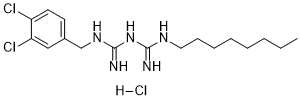Olanexidine HCl (also known as OPB-2045 HCl) is a novel monobiguanide analog with bactericidal activity. It was approved for use in Japan on Jul 03, 2015. Olanexidine is an antiseptic/disinfectant compound with potent bactericidal activity against Gram-negative and Gram-positive bacteria, for use in preparing patients for surgery and preventing of postoperative bacterial infections. Oanexidine probably binds to the cell membrane and disrupts membrane integrity and that its bacteriostatic and bactericidal effects are caused by irreversible leakage of intracellular components. At relatively high concentrations, olanexidine aggregates cells by denaturing proteins. This mechanism differs slightly from that of a similar biguanide compound, chlorhexidine.
Physicochemical Properties
| Molecular Formula | C17H28CL3N5 | |
| Molecular Weight | 408.80 | |
| Exact Mass | 407.141 | |
| Elemental Analysis | C, 49.95; H, 6.90; Cl, 26.02; N, 17.13 | |
| CAS # | 146509-94-6 | |
| Related CAS # | Olanexidine;146510-36-3 | |
| PubChem CID | 6918362 | |
| Appearance | Solid powder | |
| LogP | 6.666 | |
| Hydrogen Bond Donor Count | 4 | |
| Hydrogen Bond Acceptor Count | 2 | |
| Rotatable Bond Count | 11 | |
| Heavy Atom Count | 25 | |
| Complexity | 400 | |
| Defined Atom Stereocenter Count | 0 | |
| SMILES | Cl.ClC1=C(Cl)C=CC(CNC(N(CCCCCCCC)C(=N)N)=N)=C1 |
|
| InChi Key | GVBQOBUYEOFFLD-UHFFFAOYSA-N | |
| InChi Code | InChI=1S/C17H27Cl2N5.ClH/c1-2-3-4-5-6-7-10-22-16(20)24-17(21)23-12-13-8-9-14(18)15(19)11-13;/h8-9,11H,2-7,10,12H2,1H3,(H5,20,21,22,23,24);1H | |
| Chemical Name | -((3,4-Dichlorophenyl)methyl)-N'-octylimidodicarbonimidic diamide monohydrochloride | |
| Synonyms |
|
|
| HS Tariff Code | 2934.99.9001 | |
| Storage |
Powder-20°C 3 years 4°C 2 years In solvent -80°C 6 months -20°C 1 month Note: Please store this product in a sealed and protected environment (e.g. under nitrogen), avoid exposure to moisture and light. |
|
| Shipping Condition | Room temperature (This product is stable at ambient temperature for a few days during ordinary shipping and time spent in Customs) |
Biological Activity
| ln Vitro | Olanexidine exhibits a bactericidal mechanism that involves interactions with molecules found on the surface of bacteria, such as lipopolysaccharide and lipoteichoic acid; disruption of liposome cell membranes, which are artificial models of bacterial membranes; enhancement of membrane permeability in Escherichia coli; disruption of S. aureus membrane integrity; and denature of proteins at relatively high concentrations (≥160 μg/ml)[1]. |
| References | Antimicrob Agents Chemother.2015 Aug;59(8):4551-9. |
| Additional Infomation | See also: Olanexidine (annotation moved to); Olanexidine Hydrochloride (annotation moved to). |
Solubility Data
| Solubility (In Vitro) | DMSO : ~62.5 mg/mL (~152.89 mM) |
| Solubility (In Vivo) |
Solubility in Formulation 1: ≥ 2.08 mg/mL (5.09 mM) (saturation unknown) in 10% DMSO + 90% Corn Oil (add these co-solvents sequentially from left to right, and one by one), clear solution. For example, if 1 mL of working solution is to be prepared, you can add 100 μL of 20.8 mg/mL clear DMSO stock solution to 900 μL of corn oil and mix evenly. Solubility in Formulation 2: 10% DMSO+90% Corn Oil: ≥ 2.08 mg/mL (5.09 mM) (Please use freshly prepared in vivo formulations for optimal results.) |
| Preparing Stock Solutions | 1 mg | 5 mg | 10 mg | |
| 1 mM | 2.4462 mL | 12.2309 mL | 24.4618 mL | |
| 5 mM | 0.4892 mL | 2.4462 mL | 4.8924 mL | |
| 10 mM | 0.2446 mL | 1.2231 mL | 2.4462 mL |
